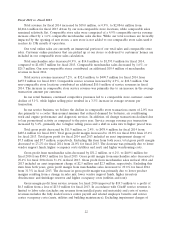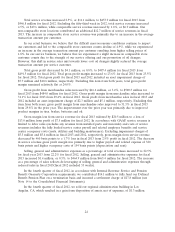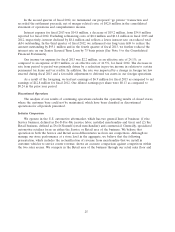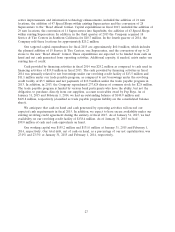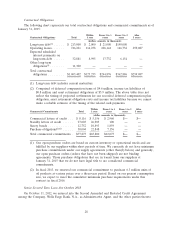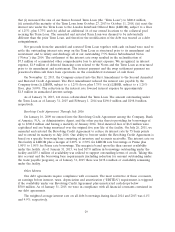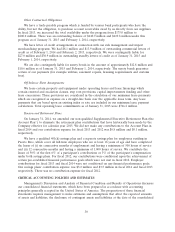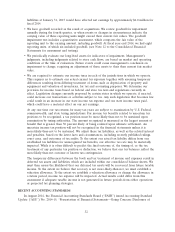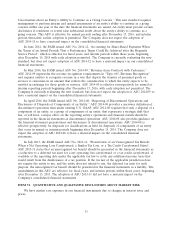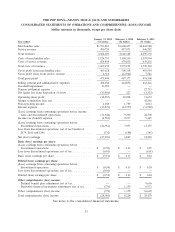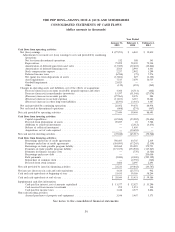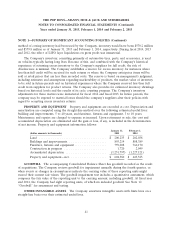Pep Boys 2014 Annual Report Download - page 37
Download and view the complete annual report
Please find page 37 of the 2014 Pep Boys annual report below. You can navigate through the pages in the report by either clicking on the pages listed below, or by using the keyword search tool below to find specific information within the annual report.financial statements and the amounts of revenues and expenses during the reporting period. On an
on-going basis, management evaluates its estimates and judgments, including those related to customer
incentives, product returns and warranty obligations, bad debts, inventories, income taxes, financing
operations, retirement benefits, share-based compensation, risk participation agreements, contingencies
and litigation. Management bases its estimates and judgments on historical experience and on various
other factors that are believed to be reasonable under the circumstances, the results of which form the
basis for making judgments about the carrying values of assets and liabilities that are not readily
apparent from other sources. Actual results may differ from these estimates under different
assumptions or conditions.
We believe that the following represent our more critical estimates and assumptions used in the
preparation of the consolidated financial statements:
• Inventory is stated at lower of cost, as determined under the last-in, first-out (LIFO) method, or
market. Our inventory, which consists primarily of automotive parts and accessories, is used on
vehicles. Because of the relatively long lives of vehicles, along with our historical experience of
returning most excess inventory to our suppliers for full credit, the risk of obsolescence is
minimal. We establish a reserve for excess inventory for instances where less than full credit will
be received for such returns and where we anticipate items will be sold at retail prices that are
less than recorded costs. The reserve is based on management’s judgment, including estimates
and assumptions regarding marketability of products, the market value of inventory to be sold in
future periods and on historical experiences where we received less than full credit from
suppliers for product returns. If our estimates regarding excess inventory are inaccurate, we may
incur losses or gains that could be material. A 10% difference in our inventory reserves as of
January 31, 2015 would have affected net earnings by approximately $0.5 million in fiscal 2014.
• We receive various payments and allowances from our vendors through a variety of programs
and arrangements, including allowances for warranties, advertising and general promotion of
vendor products. Vendor allowances are treated as a reduction of inventory, unless they are
provided as a reimbursement of specific, incremental, identifiable costs incurred by the Company
in selling the vendor’s products. The vast majority of the vendor funds received are recorded as
a reduction of the cost of inventories and recognized as a reduction to cost of sales as these
inventories are sold.
Based on our vendor agreements, a significant portion of vendor funding we receive is based on
our inventory purchases. Therefore, we record receivables for funding earned but not yet
received as we purchase inventory. During the year, we regularly review the receivables from
vendors to ensure vendors are able to meet their obligations. We generally have not recorded a
reserve against these receivables as we have legal right of offset with our vendors for payments
owed them. Historically, we have had immaterial write-offs in each of the last three years.
• We record reserves for future sales returns, customer incentives, warranty claims and inventory
shrinkage. The reserves are based on expected returns of products and historical claims and
inventory shrinkage experience. If actual experience differs from historical levels, revisions in our
estimates may be required. A 10% change in these reserves at January 31, 2015 would have
affected net earnings by approximately $0.6 million for fiscal 2014.
• We have risk participation arrangements with respect to workers’ compensation, general liability,
automobile liability and other casualty coverage, including stop loss coverage with third party
insurers to limit our total exposure. A reserve for the liabilities associated with these agreements
is established using generally accepted actuarial methods followed in the insurance industry and
our historical claims experience. The amounts included in our costs related to these
arrangements are estimated and can vary based on changes in assumptions, claims experience or
the providers included in the associated insurance programs. A 10% change in our self-insurance
31



